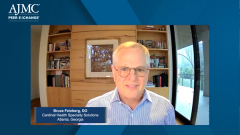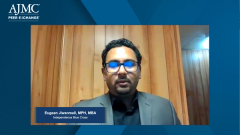
Comprehensive Genomic Profiling and Procedure Coding
Criteria used by payers to determine how to code and support the use of various genomic profiling assays used in oncology.
Episodes in this series

Bruce Feinberg, DO: Before we get to billing, whether it was 50, 150, or 500 genes, if the costs were the same, are there other issues with the number tested from a payer perspective?
Eugean Jiwanmall, MPH, MBA: I’ll give a simple answer. Kenna is going to like this. Kenna, I hear you, maybe there’s some variation in how your institution is billing or who’s is responsible for paying for it. Let me answer Bruce’s part.
Bruce, this is what I was talking about from my evolution perspective of how things have changed from Sanger…sequencing—small panels, big panels, we have to deal with it. When it comes to procedure coding for some of this comprehensive genomic profiling [CGP], you have specific codes. You can do a 1:1 ratio: this procedure code is for CGP X. From there, you can evaluate the test. Let me pick on that example. We’re taking the cost portion out of it. When you have a specific code for 1 CGP or a large panel or a small panel—whatever panel you want to call it—you’re going to look toward 2 things because that panel is likely going to have at least 1 to 2 clinically actionable genes. Hear me out, Kenna. From a cost perspective, does it make sense to pay for the panel or pay for the individual genes? That decision depends on whom you’re working with, the utilization management or institution. I’m not speaking for everybody. I’m giving general examples. That’s a specific procedure, for example.
Bruce Feinberg, DO: That’s still a cost issue.
Eugean Jiwanmall, MPH, MBA: It will become a cost issue as long as there are at least 1 or more clinically actionable genes within the case that you’re reviewing. I’m bringing it to the group or case level. I’m not giving you a policy criterion or a policy decision for the panel in general. We’re talking about individualized medicine. For that particular case, if it’s a nonspecific test, if it’s a nonspecific situation, and you have comprehensive genomic profiling coming from multiple institutions…there are 2 ways they will bill for it. Either they’ll bill nonspecific, and there are procedure codes out there are for it. I’m using a general example that ends with 50-plus genes. They give several examples of particular markers in the code narrative, and it says 50-plus. Or you’re billing individually for each gene marker out there.
The review happens the same way. You take a look at the makeup of the test that’s out there, and you try your best to connect it back to the actual case specifics. This goes back to the 150 because we can all agree that not all 150 are going to make sense clinically for a particular case. But maybe 1 or 2 make sense. Let’s pick on non–small cell lung cancer, where you have at least 5 therapies available, and your clinical decision point is where all 5 are on the table—stay with me on this, because you’re going to like this answer. For non–small cell lung cancer, let’s say all 5 therapies are on the table. These are established markers. If you have expression, or a presence or absence of this particular marker, or you go on this therapy, then you’re at that decision point.
Instead of sequencing for 5 different ones—and I’m making this up—it may cost you $10,000. If there’s a panel out there, irrespective of where the panel is coming from, that has those particular 5 markers and it’s going to cost less than $10,000, at that decision point you’re on the prioritization call, and you’re going to approve the panel. That’s what the cost aspect bring into it. But the reason why I don’t want to continue highlight the cost piece of it is because I don’t want to keep away the establishment of clinical usefulness if you have a great profile test. Yes, you can skip establishing clinical validity for a marker that’s out there. But we have multiple examples, and I don’t want to endorse 1. I have to be careful about this because of my role. There are panel tests where there are hundreds of markers involved. We’re talking about RNA expression or the DNA level. They try to gather data to distinguish themselves, so Eugean doesn’t have to go through these algorithms that he just explained from a cost-effectiveness portion because nobody is going to make a panel test, no matter the size, if there’s not a single actionable gene.
That’s always going to be there so everybody can make the case. If you want to distinguish yourself—this is for the audience but also for my fellow panelists—get direct evidence for your profile. Kenna, I’m sure that at your institution, [The University of Texas] MD Anderson [Cancer Center], the profile differs from the academic centers I have to deal with on a regular basis at Penn and Jefferson in Philadelphia. If Penn tells me “My CGP is better than Kenna’s CGP at MD Anderson,” then I know that both are going to have limitations and benefits, but I’m not going to argue with them on the 20 markers…because 1 is going to ask why the variation that I’m able to pick up is better.
Bruce Feinberg, DO: I hear you, but it seems like the simplified answer is that we’re going to cap it, here’s our price, and you build whatever panel you want to build. This is what we pay for the panel.
Eugean Jiwanmall, MPH, MBA: It’s not that we’re going to cap. I don’t want to call it a cap…because folks are going to be like, “It’s $3000, but I’m going to give it to you for $2000.” Contract me, I’m better than Kenna and better than Mark [Kris], so contract me because we’ll give you a lower rate. That’s why I’m not going to get into the capital prices. There are established fees, so let me be generic about this.
Bruce Feinberg, DO: Hold the thought on established fees.
Transcript edited for clarity.
Newsletter
Stay ahead of policy, cost, and value—subscribe to AJMC for expert insights at the intersection of clinical care and health economics.







































